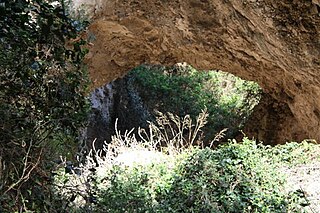
Rathcroghan is a complex of archaeological sites near Tulsk in County Roscommon, Ireland. It is identified as the site of Cruachan, the traditional capital of the Connachta, a term used to describe the prehistoric and early historic rulers of the western territory. The Rathcroghan Complex is a unique archaeological landscape with many references found in early Irish medieval manuscripts.

The Russell Cave National Monument is a U.S. National Monument in northeastern Alabama, United States, close to the town of Bridgeport. The Monument was established on May 11, 1961, when 310 acres (1.3 km2) of land were donated by the National Geographic Society to the American people. It is now administered and maintained by the National Park Service. The National Monument was listed on the National Register of Historic Places on October 15, 1966.

Henry Christy was an English banker and collector, who left his substantial collections to the British Museum.
Sof Omar Cave is the longest cave in Ethiopia at 15.1 kilometres (9.4 mi) long; sources claim it is the longest system of caves in Africa. It is situated to the east of Robe, in the Bale Zone of the Oromia Region in southeastern Ethiopia, through which the Weyib River flows. It sinks at the Ayiew Maco entrance and reappears at the Holuca resurgence 1 kilometre (0.62 mi) away. According to tradition Sof Omar was the name of a Muslim holy man who lived in the area and Ayiew the name of his daughter. Maco and Holuca are local names for 'name' and 'cave', respectively. Long a religious centre, it is sacred both to Islam and the local Oromo traditional religion. The caves are known for their many pillars, particularly in the 'Chamber of Columns'.
Nicholas Crane is an English geographer, explorer, writer and broadcaster. Since 2004 he has written and presented four notable television series for BBC Two: Coast, Great British Journeys, Map Man and Town.

David George Hogarth,, also known as D. G. Hogarth, was a British archaeologist and scholar associated with T. E. Lawrence and Arthur Evans. He was Keeper of the Ashmolean Museum, Oxford from 1909 to 1927.

Bays Mountain is a ridge of the Ridge-and-Valley Appalachians, located in eastern Tennessee. It runs southwest to northeast, from just south of Knoxville to Kingsport.

Zedekiah's Cave — also called Solomon's Quarries — is a 5-acre (20,000 m2) underground meleke limestone quarry that runs the length of five city blocks under the Muslim Quarter of the Old City of Jerusalem. It was carved over a period of several thousand years and is a remnant of the largest quarry in Jerusalem, stretching from Jeremiah's Grotto and the Garden Tomb to the walls of the Old City. The cave has great historical importance in Freemasonry.

Parc Cwm long cairn, also known as Parc le Breos burial chamber, is a partly restored Neolithic chambered tomb, identified in 1937 as a Severn-Cotswold type of chambered long barrow. The cromlech, a megalithic burial chamber, was built around 5850 years before present (BP), during the early Neolithic. It is about seven 1⁄2 miles (12 km) west south–west of Swansea, Wales, in what is now known as Coed y Parc Cwm at Parc le Breos, on the Gower Peninsula.

The Grotta di Matromania is a large, natural cave on the east coast of the island of Capri, Italy. It is located near the Arco Naturale. The cave is approximately 27 m long, 18 m wide, and 18 m high. It is connected with Mithras.
The Grotta del Castiglione is a lofty cave on the island of Capri, Italy. It is located high up in the hill of the same name, facing south. When the inhabitants of Capri took refuge in it at the time of the Turkish raids, there was a way to it from the east, but the path has since been destroyed by the crumbling of the cliff.
The Grotta dell'Arsenale is a cave on the island of Capri, southern Italy.
The Grotta Bianca is a sea cave located on the island of Capri, Italy. It derives its name from white incrustations of calcareous matter upon its sides, and from clusters of white stalactites which hang from the roof and fringe the entrance. The cave faces east and is situated near the Punta della Chiavioa. The entry, about 70–80 feet (21–24 m) high, leads into upper and lower caves, of which the former is not easily accessible. The lower cave can be entered by boat for a short distance. Unlike most other caves at the water-level, it is much broader at approximately 6 feet (1.8 m) above the water than actually at the surface. The total height is no more than 24 feet (7.3 m). The upper erosion line is clearly marked near the cave and within it. The upper cave seems to belong to an earlier period.
The Grotta Verde is a sea cave located on the island of Capri, southern Italy.
Cave S is a limestone cave in the British Overseas Territory of Gibraltar. It is located on the eastern side of the Rock of Gibraltar, near Holy Boy's Cave. Human remains were found in the cave in 1910 that did not appear to be of a modern man.

Gondrani, also known as Shehr-e-Roghan, is an archaeological site near the town of Bela in Balochistan, Pakistan.
Encyclopedias from ca. 1900 note that ancient tombs, pyramidal structures, ruined towns, and stone walls found in Somalia, such as the Wargaade Wall, are evidence of an old civilization in the Somali peninsula that predates Islam.

Mount Tupper 2,804 m (9,199 ft) is a mountain about 37 kilometres (23 mi) west of Golden, British Columbia, Canada and three kilometres east of Rogers Pass in Glacier National Park. Part of the Selkirk Mountains, it was formerly named Hermit Mountain until renamed (1887) in honour of Sir Charles Tupper when he was minister of Railways and Canals in Sir John A. Macdonald's cabinet during the siting and construction of the CPR line through the Selkirk Mountains, and later Prime Minister.

Fossil Cave (5L81), formerly known as The Green Waterhole, is a cave in the Limestone Coast region of south-eastern South Australia. It is located in the gazetted locality of Tantanoola about 22 kilometres north-west of the city of Mount Gambier, only a few metres from the Princes Highway between Mount Gambier and Millicent. It is notable both as a paleontological site and as a cave diving site.

Windmill Hill Cavern is a limestone cave system in the town of Brixham, Devon. It was discovered in 1858 and later excavated by a team led by the geologist William Pengelly, who found proof that humans co-existed with extinct British fauna.














